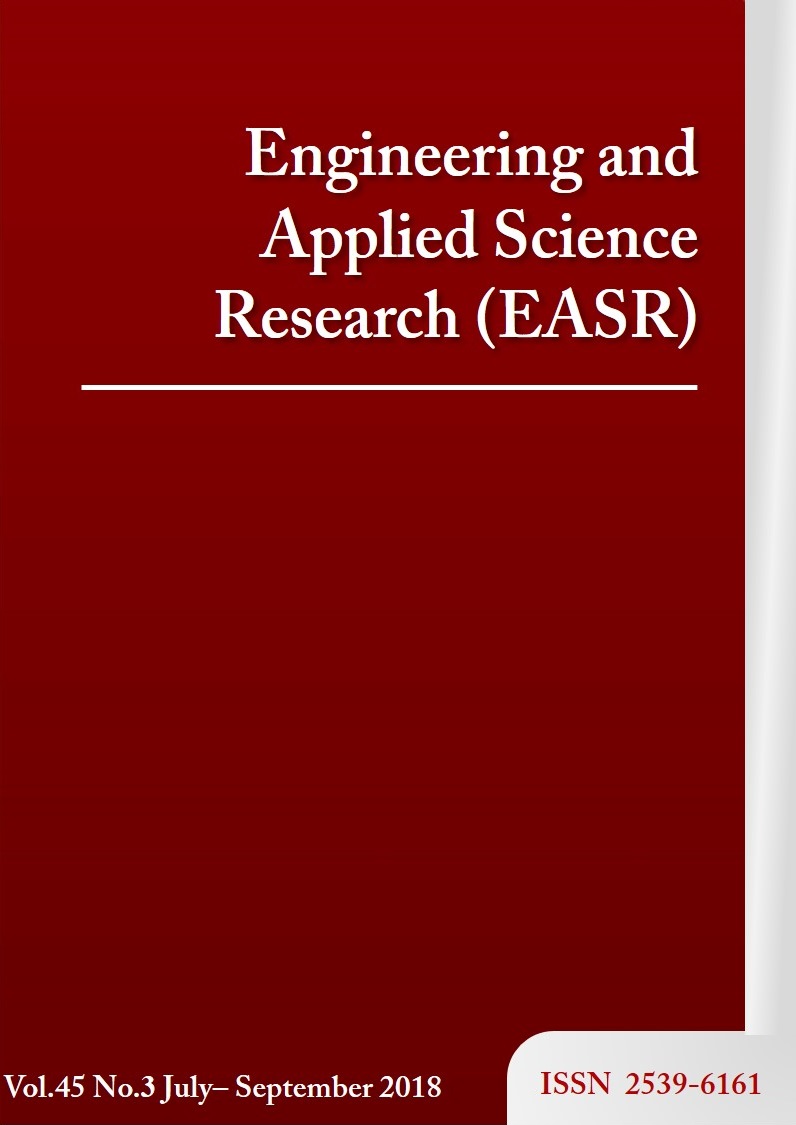Reduction of RSSI variations for indoor position estimation in wireless sensor networks
Main Article Content
Abstract
In this paper, the reduction of RSSI (received signal strength indicator) variation for indoor position estimation in wireless sensor networks (WSNs) is studied through simulation. We demonstrate that using raw RSSI data (with high variation) to estimate a sensor position (i.e., an unknown position) is not appropriate due to a large estimation error. To cope with this problem, we propose a RSSI improvement method for reducing RSSI variation. The sum of the average RSSI value used at the previous step and the RSSI value measured at the current step are employed to determine the appropriate RSSI value (i.e., the smoothed RSSI value). The priority technique is also applied to such a function by assigning different weighted values. Simulation results show that using our proposed method with an optimal weighted value gives better estimation results than using raw RSSI data and a moving average method. With the proposed method, the position estimation by an original trilateration approach is more accurate.
Article Details
This work is licensed under a Creative Commons Attribution-NonCommercial-NoDerivatives 4.0 International License.
References
Akyildiz IF, Su W, Sankarasubramanism Y, Cayirci E. Wireless sensor networks: a survey. Computer Networks 2002;38:393-422.
Booranawong A, Teerapabkajorndet W, Limsakul C. Energy consumption and control response evaluations of AODV routing in WSANs for building-temperature control. Sensors 2013;13:8303-8330.
Cheng L, Wu C, Zhang Y, Wu H, Li M, Maple C. A survey of localization in wireless sensor network. International Journal of Distributed Sensor Networks 2012.
Gao P, Shi WR, Zhou W, Li HB, Wang XG. An adaptive RSSI compensation strategy based on simulated annealing for indoor cooperative localization. Information Technology Journal 2013;12:712-719.
Liu H, Darabi H, Banerjee P, Liu J. Survey of wireless indoor positioning techniques and systems. IEEE Transaction on Systems, Man, and Cybernetics-Part C: Applications and Reviews 2007;37:1067-1080.
Patwari N, Ash JN, Kyperountas S, Hero AO, Moses RL, Correal NS. Locating the nodes: cooperative localization in wireless sensor networks. IEEE Signal Magazine 2005;22:54-69.
Laaraiedh M, Yu L, Avrillon S, Uguen B. Comparison of hybrid localization schemes using RSSI, TOA, and TDOA. Proceedings of Wireless Conference 2011-Sustainable Technologies (European Wireless); 2011. p. 1-5.
Wang G, Yang K. A new approach to sensor node localization using RSS measurements in wireless sensor networks. IEEE Transaction on Wireless Communications 2011;10:1389–1395.
Thongpull K, Jindapetch N, Teerapabkajorndet W. Wireless ESD event locator systems in hard disk drive manufacturing environments. IEEE Transaction on Industrial Electronics 2012;59.
Thongpull K, Jindapetch N, Teerapabkajorndet W. A neural network based optimization for wireless sensor node position estimation in industrial environments. Proceedings of the International on Electrical Engineering/Electronics Computer Telecommunications and Information Technology; 2010. p. 249-253.
Machaj J, Brida P. Impact of radio fingerprints processing on localization accuracy of fingerprinting algorithms. Elektronika Ir Elecktrotechnika 2012;123.
Li X, Zhang Y, Xu K, Fan G, Wu H. Research of localization and tracking algorithms based on wireless sensor network. Journal of Information & Computation Science 2011;8:708-715.
Karl H, Willig A, Protocol and architectures for wireless sensor networks. John Wiley & Sons, New York, 2005.
Guo Z, Guo Y, Hong F, Jin Z, He Y, Feng Y, Lui Y. Perpendicular intersection: localization wireless sensor with mobile beacon. IEEE Transaction on Vehicular Technology 2010;59:3501-3509.
Laaraiedh M. Contribution on hybrid localization techniques for heterogeneous wireless networks. PhD. Thesis. University of Rennes; 2010.
Papamanthou C, Preparata FP, Tamassia R. Algorithms for location estimation based on RSSI sampling. Algorithmic Aspects of Wireless Sensor Networks Lecture Notes in Computer Science, Springer, 2008;5389:72-86.
Gnanasekaran P, Rangaswamy TR. Node dB level based stable QoS routing protocol for mobile ad-hoc networks. European Journal of Scientific Research 2012:79:362–374.
Booranawong A, Teerapabkajorndet W. Reduction of exploratory data messages on directed diffusion in mobile wireless sensor networks. Proceedings of the 6th International Conference on Electrical Engineering/Electronics, Computer, Telecommunications and Information Technology (ECTI-2009); 2009. p. 996-999.
Booranawong A, Teerapabkajorndet W. Impact of radio propagation on the performance of directed diffusion routing in mobile wireless sensor networks. Proceedings of the International Conference on Embedded Systems and Intelligent Technology (ICESIT-2009); 2009.
McCanne S, Floys S. NS-2 network simulator. Available from: http://www.isi.edu/nsnam/ns.
Instruments T. CC2500 datasheet. Available from: http://www.ti.com/lit/ds/symlink/cc2500.pdf.
Jindamaneepon W, Rattanalert B, Sengchuai K, Booranawong A, Saito H, Jindapetch N. A novel FPGA-based multi-channel multi-interface wireless node: implementation and preliminary test. Advanced Computer and Communication Engineering Technology, Lecture Notes in Electrical Engineering 2016; 1163-1173.
Rattanalert B, Jindamaneepon W, Sengchuai K, Booranawong A, Jindapetch N. Problem investigation of min-max method for RSSI based indoor localization. Proceedings of the 12th International Conference on Electrical Engineering/Electronics, Computer, Telecommunications and Information Technology; 2015. p.1-5.
Koh SJ. RF characteristic of Mica-Z wireless sensor network motes. Master Thesis. Naval Postgraduate School 2006.
Jung H, Chang YJ, Ingram MA. Experiment range extension of concurrent cooperative transmission in indoor environments at 2.4GHz. Proceedings of the IEEE Military Communication Conference; 2010. p. 148-153.
Ghassemzadeh S, Greenstein LJ, Kavcic A, Sceunsson T, Tarokh V. An empirical indoor path loss model for ultra-wideband channel. Journal of Communications and Networks 2003;5:303-308.
Dong Q, Dargie W. Evaluation of the reliability of RSSI for indoor localization. Proceedings of the International Conference on Wireless Communications in Unusual and Confined Areas; 2012. p. 1-6.
Shin SC, Son BR, Kim WG, Kim JG. ERFS: enhanced RSSI value filtering schema for localization in wireless sensor networks. Wireless Sensor and Actor Networks II 2008; 264:245–256.
Sittiruk T, Booranawong A, Jindapetch N. Preliminary study of LMS based RSSI calibration for indoor localization. Proceedings of the 29th International Technical Conference on Circuit/Systems Computers and Communications (ITC-CSCC); 2014. p. 916-919.



